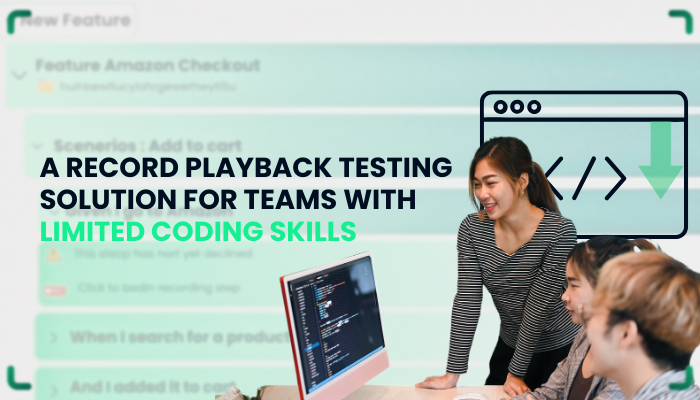Every development team wants reliable test automation. But not every team has seasoned coders to write complex scripts from scratch. Fortunately, record playback testing has emerged as a go-to option for teams looking to automate testing with minimal technical lift. Whether you’re a QA analyst, a product owner, or a functional tester, the promise of recording user actions and replaying them as automated tests has become a game-changer.
This article dives deep into how record playback testing tools empower low-code teams, eliminate bottlenecks, and streamline test creation without requiring expert programming knowledge.
Here’s how they’re reshaping the software testing landscape.
What Is Record Playback Testing and Why It Matters
Record playback testing refers to a method of automating tests where user actions are captured during a session and converted into executable test cases. The “record” phase captures mouse clicks, form inputs, and navigations; the “playback” phase re-executes those actions to verify software behavior.
This technique matters because it
- Drastically reduces the time needed to write test scripts
- Makes test automation accessible to manual testers and business users
- Provides immediate validation of workflows and UI changes
And yes, all of this without needing a degree in software engineering.
Lowering the Barrier to Entry for Test Automation
Not every QA team is staffed with Python or Java experts. Many testers bring deep domain expertise but little-to-no coding knowledge. That’s where record playback testing tools shine.
- Drag-and-drop interfaces replace complex syntax
- Real-time test creation through interaction with the UI
- Tools often integrate with BDD or Gherkin to maintain clarity
This creates a more inclusive environment, allowing a wider range of contributors to participate in quality assurance.
Faster Feedback Loops in Agile Environments
Speed is everything when you’re working in short sprints. One of the biggest wins with record playback testing is the ability to create test coverage quickly, enabling near-instant feedback on product changes.
Here’s what this means in practice
- Test cases can be recorded as soon as a new feature is implemented
- Developers and testers get immediate validation on builds
- Shortened release cycles with fewer regression issues
This feedback acceleration is especially useful for CI/CD pipelines where rapid iteration is crucial.
Bridging the Gap Between Developers and QA Analysts
The disconnect between development and QA can lead to delays, misunderstandings, and buggy releases. Record playback testing tools serve as a bridge, allowing QA teams to communicate in a language closer to how applications function- visually and sequentially.
Key advantages include
- Better collaboration between roles with varying technical backgrounds
- Easier handoffs and reviews of test flows
- Clear mapping of user journeys to test scripts
It’s all about speaking a shared language without getting lost in technical jargon.
Built-in Maintenance and Test Reusability
One of the long-standing criticisms of record playback testing has been test flakiness. However, modern solutions have introduced smart element selectors, data-driven testing, and modular test components to boost reusability.
Here’s what you gain
- Easily update one module and reflect changes across multiple tests
- Dynamic element handling reduces false negatives
- Reduce test maintenance effort significantly
So, record playback isn’t just a beginner’s tool anymore- it’s robust enough for professional use.
Enhanced Productivity for Functional and Manual Testers
Manual testers can often feel left out when companies move toward full test automation. Record playback testing changes the equation by enabling non-developers to contribute meaningful test cases.
- Manual testers can record processes they’re already performing
- The same tests can be reused across multiple builds or environments
- Shifts manual testing toward automated regression coverage
This expands the capacity of QA teams without hiring additional automation engineers.
No-Code Doesn’t Mean No-Control
One might assume that record playback testing sacrifices precision. Not quite. Modern platforms offer advanced editing options, conditional logic, loops, and API calls- all wrapped in user-friendly interfaces.
Features may include
- Script-level editing for power users
- Parameterization and data injection
- Customizable assertion libraries
So even if you’re not a coder, you’re not stuck with cookie-cutter test flows.
Improved Documentation and Traceability
Because record playback testing captures steps as they happen, it naturally creates a test script that doubles as documentation. This helps QA leads, product managers, and auditors understand what’s being tested.
- Step-by-step screenshots or logs
- Version control for test flows
- Tags and labels for easier categorization
Clearer documentation also helps onboard new team members or stakeholders.
Seamless Integration with CI/CD Workflows
No automation tool is complete without the ability to plug into DevOps processes. Record playback testing solutions typically support integrations with popular CI/CD tools like Jenkins, CircleCI, or GitHub Actions.
Integration benefits
- Run recorded tests as part of nightly builds or deployment gates
- Catch UI regressions automatically before production release
- Send test results to dashboards or messaging platforms
This transforms testing from a manual task to a continuous quality checkpoint.
How Record Playback Testing Supports BDD Practices
If your team already uses Behavior Driven Development (BDD), combining it with record playback testing can supercharge your automation efforts. Some platforms now allow tests to be generated using Gherkin syntax from recorded actions.
Benefits include
- Reusable features written in plain English
- Syncing user stories with test automation
- Faster creation of acceptance criteria
This alignment brings developers, testers, and business analysts onto the same page- literally.
Flexible Platforms That Grow with You
While record playback testing tools are great for beginners, they’re also built to scale. As teams mature, they can integrate custom logic, export test code, and implement hybrid automation strategies.
A scalable platform typically includes
- Plugin support or custom scripting
- Team-based access control
- Analytics and reporting dashboards
This future-proofing makes record playback testing a long-term solution, not just a stopgap.
For Record Playback Testing: Try Testevolve
You can choose Testevolve for your record playback testing needs. With the increasing adoption of BDD and the desire to use low-code test automation solutions, many teams have been seeking the perfect pairing of the two.
With the Flare Test Recorder, agile automation testers can now experience the first seamless integration of BDD and recorded tests. You can go through the Testevolve website, sign up with your query, and use the Free 30-day trial on us.
Read Our Recent Trending Blog – Boost Your Website’s Conversion Rates with Accessibility Testing Tools
 :
https://uk.pinterest.com/testevolve/
:
https://uk.pinterest.com/testevolve/












